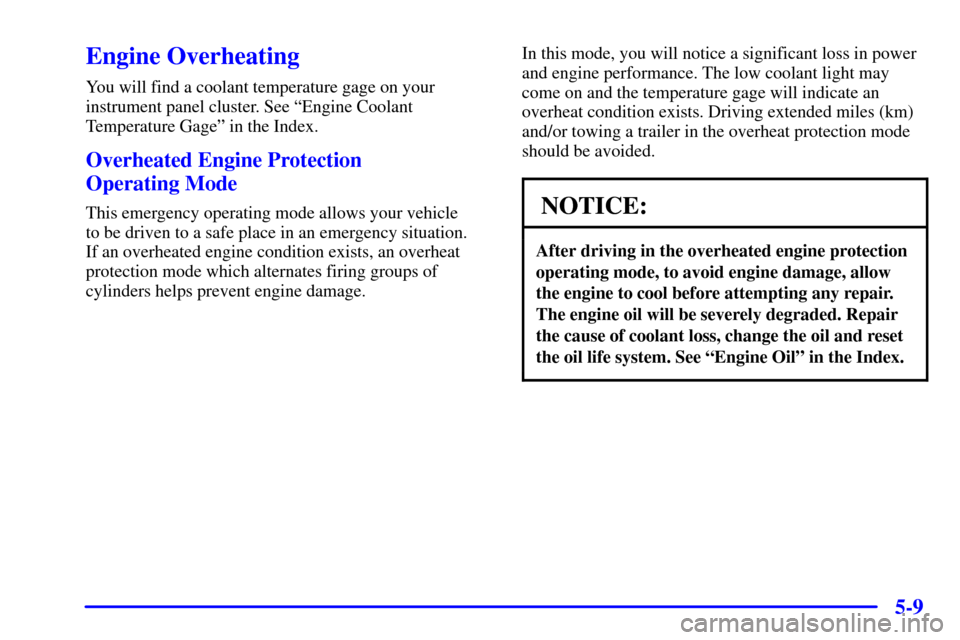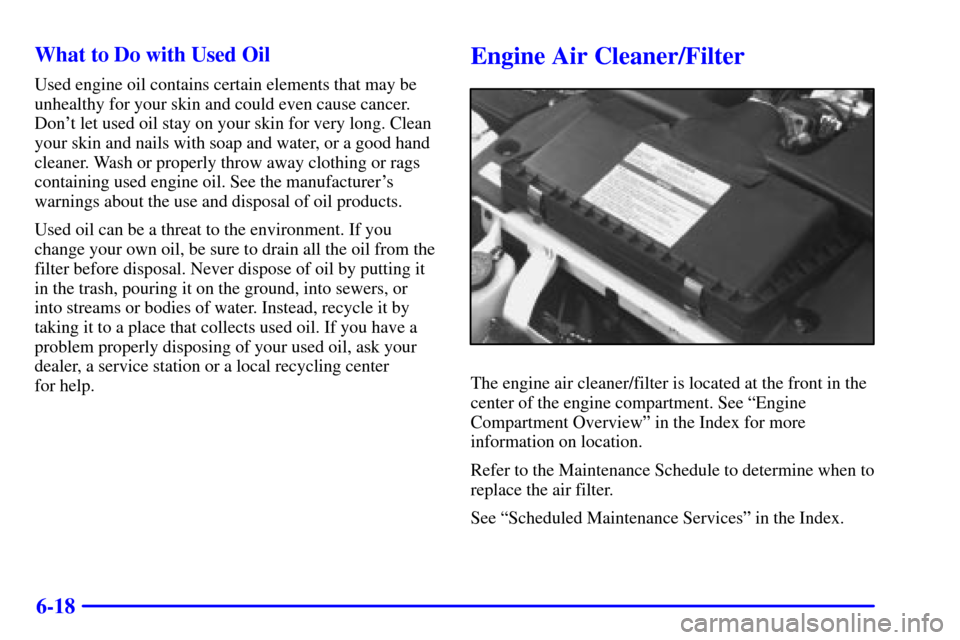Page 149 of 356

2-96 Low Oil Light
This warning light should
come on briefly while you
are starting your engine.
If the light doesn't come on,
have it repaired.
If the light stays on after starting your engine, your
engine oil level may be too low. You may need to add
oil. See ªEngine Oilº in the Index.
NOTICE:
The oil level monitoring system only checks
the oil level when you are starting your engine.
It does not keep monitoring the level once the
engine is running. Also, the oil level check only
works when the engine has been turned off long
enough for the oil to drain back into the oil pan.
Oil Change Light
This OIL CHANGE light
should come on briefly as a
bulb check when you start
the engine. If the OIL
CHANGE light doesn't
come on, have it serviced.
If the OIL CHANGE light comes on and stays on
for 60 seconds after you start the engine, have the
oil changed.
For additional information, see ªEngine Oil, When to
Changeº in the Index. After changing the engine oil, the
system must be reset. See ªHow to Reset the Oil Change
Lightº in the Index.
Page 219 of 356

5-9
Engine Overheating
You will find a coolant temperature gage on your
instrument panel cluster. See ªEngine Coolant
Temperature Gageº in the Index.
Overheated Engine Protection
Operating Mode
This emergency operating mode allows your vehicle
to be driven to a safe place in an emergency situation.
If an overheated engine condition exists, an overheat
protection mode which alternates firing groups of
cylinders helps prevent engine damage.In this mode, you will notice a significant loss in power
and engine performance. The low coolant light may
come on and the temperature gage will indicate an
overheat condition exists. Driving extended miles (km)
and/or towing a trailer in the overheat protection mode
should be avoided.NOTICE:
After driving in the overheated engine protection
operating mode, to avoid engine damage, allow
the engine to cool before attempting any repair.
The engine oil will be severely degraded. Repair
the cause of coolant loss, change the oil and reset
the oil life system. See ªEngine Oilº in the Index.
Page 240 of 356
5-30
5. Remove any rust or dirt
from the wheel bolts,
mounting surfaces and
spare wheel.
CAUTION:
Rust or dirt on the wheel, or on the parts to
which it is fastened, can make the wheel nuts
become loose after a time. The wheel could come
off and cause an accident. When you change a
wheel, remove any rust or dirt from the places
where the wheel attaches to the vehicle. In an
emergency, you can use a cloth or a paper towel
to do this; but be sure to use a scraper or wire
brush later, if you need to, to get all the rust or
dirt off.
CAUTION:
Never use oil or grease on studs or nuts. If you
do, the nuts might come loose. Your wheel could
fall off, causing a serious accident.
Page 260 of 356

6-14 When to Add Engine Oil
If the oil is at or below the ADD line, then you'll need
to add at least one quart of oil. But you must use the
right kind. This part explains what kind of oil to use.
For engine oil crankcase capacity, see ªCapacities and
Specificationsº in the Index.
NOTICE:
Don't add too much oil. If your engine has so
much oil that the oil level gets above the
cross
-hatched area that shows the proper
operating range, your engine could be damaged.
The oil fill cap is located at the rear of your engine
compartment on the passenger's side of the vehicle. See
ªEngine Compartment Overviewº in the Index for more
information on location.
Be sure to fill it enough to put the level somewhere in
the proper operating range. Push the dipstick all the way
back in when you're through.
What Kind of Engine Oil to Use
Oils recommended for your vehicle can be identified by
looking for the starburst symbol.
This symbol indicates that the oil has been certified by
the American Petroleum Institute (API). Do not use any
oil which does not carry this starburst symbol.
If you change your own oil,
be sure you use oil that has
the starburst symbol on the
front of the oil container. If
you have your oil changed
for you, be sure the oil put
into your engine is
American Petroleum
Institute certified for
gasoline engines.
You should also use the proper viscosity oil for your
vehicle, as shown in the following chart:
Page 261 of 356
6-15
5.7L V8 EngineAs in the chart shown previously, if you have the
5.7L V8 engine, SAE 5W
-30 is best for your vehicle.
However, you can use SAE 10W
-30 if it's going to be
0�F (
-18�C) or above. These numbers on an oil
container show its viscosity, or thickness. Do not use
other viscosity oils, such as SAE 20W
-50.
As shown in the following chart, if you have the
3800 V6 engine, SAE 10W
-30 is best for your vehicle.
However, you can use SAE 5W
-30 if it's going to be
colder than 60�F (16�C) before your next oil change.
When it's very cold, you should use SAE 5W
-30.
These numbers on an oil container show its viscosity,
or thickness. Do not use other viscosity oils, such
as SAE 20W
-50.
Page 263 of 356

6-17 When to Change Engine Oil
(GM Oil Life System�)
Your vehicle has a computer system that lets you know
when to change the engine oil and filter. This is based on
engine revolutions and engine temperature, and not on
mileage. Based on driving conditions, the mileage at
which an oil change will be indicated can vary
considerably. For the oil life system to work properly,
you must reset the system every time the oil is changed.
When the system has calculated that oil life has been
diminished, it will indicate that an oil change is
necessary. A OIL CHANGE light will come on. Change
your oil as soon as possible within the next two times
you stop for fuel. It is possible that, if you are driving
under the best conditions, the oil life system may not
indicate that an oil change is necessary for over a year.
However, your engine oil and filter must be changed at
least once a year and at this time the system must be
reset. It is also important to check your oil regularly and
keep it at the proper level.
If the system is ever reset accidentally, you must change
your oil at 3,000 miles (5 000 km) since your last oil
change. Remember to reset the oil life system whenever
the oil is changed.How to Reset the Oil Change Light
The GM Oil Life System� calculates when to change
your engine oil and filter based on vehicle use. Anytime
your oil is changed, reset the system so it can calculate
when the next oil change is required. If a situation
occurs where you change your oil prior to a OIL
CHANGE light being turned on, reset the system.
After changing the engine oil, the system must be reset.
1. Turn the ignition key to RUN with the engine
turned off.
2. Press the TRIP/OIL RESET button located on the
instrument panel for 12 seconds.
The OIL CHANGE light will start to flash to confirm
that the system is reset. The reset is complete when the
OIL CHANGE light goes out.
Page 264 of 356

6-18 What to Do with Used Oil
Used engine oil contains certain elements that may be
unhealthy for your skin and could even cause cancer.
Don't let used oil stay on your skin for very long. Clean
your skin and nails with soap and water, or a good hand
cleaner. Wash or properly throw away clothing or rags
containing used engine oil. See the manufacturer's
warnings about the use and disposal of oil products.
Used oil can be a threat to the environment. If you
change your own oil, be sure to drain all the oil from the
filter before disposal. Never dispose of oil by putting it
in the trash, pouring it on the ground, into sewers, or
into streams or bodies of water. Instead, recycle it by
taking it to a place that collects used oil. If you have a
problem properly disposing of your used oil, ask your
dealer, a service station or a local recycling center
for help.
Engine Air Cleaner/Filter
The engine air cleaner/filter is located at the front in the
center of the engine compartment. See ªEngine
Compartment Overviewº in the Index for more
information on location.
Refer to the Maintenance Schedule to determine when to
replace the air filter.
See ªScheduled Maintenance Servicesº in the Index.
Page 267 of 356

6-21
Automatic Transmission Fluid
When to Check and Change
A good time to check your automatic transmission fluid
level is when the engine oil is changed.
Change both the fluid and filter every 15,000 miles
(25 000 km) if the vehicle is mainly driven under one or
more of these conditions:
�In heavy city traffic where the outside temperature
regularly reaches 90�F (32�C) or higher.
�In hilly or mountainous terrain.
�Uses such as high performance operation.
�When doing frequent trailer towing.
�Uses such as found in taxi, police or delivery service.
If you do not use your vehicle under any of these
conditions, change the fluid and filter every
50,000 miles (83 000 km).
See ªScheduled Maintenance Servicesº in the Index.
How to Check
Because this operation can be a little difficult, you
may choose to have this done at the dealership
service department.
If you do it yourself, be sure to follow all the
instructions here, or you could get a false reading on
the dipstick.
NOTICE:
Too much or too little fluid can damage your
transmission. Too much can mean that some of
the fluid could come out and fall on hot engine
parts or exhaust system parts, starting a fire.
Too little fluid could cause the transmission to
overheat. Be sure to get an accurate reading if
you check your transmission fluid.